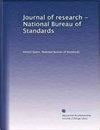Conferences/Events: WORKSHOP ON MICROSTRUCTURE AND MACROMOLECULAR RESEARCH WITH COLD NEUTRONS National Bureau of Standards, Gaithersburg, MD, April 21–22, 1988
Journal of research of the National Bureau of Standards
Pub Date : 1988-11-01
DOI:10.6028/jres.093.161
引用次数: 0
Abstract
On April 21-22, 1988, over 160 scientists, including 25 from industry, 70 from universities and 30 from government laboratories and agencies (not including NBS), gathered at NBS, Gaithersburg, for a Workshop on Microstructure and Macromolecular Research with Cold Neutrons. This workshop was one of a series, each devoted to a major area of research with cold neutrons, that are being held in conjunction with the development of the Cold Neutron Research Facility (CNRF) at the NBS 20 MW research reactor as a national, useroriented research facility. The dual aims of this workshop were to highlight research opportunities in the application of cold neutron techniques to the study of submicron structure in materials and macromolecular systems, and to inform and involve the scientific community in the planning for instrumentation for the CNRF. The long wavelength neutrons that are produced by a cold moderator, such as the 40 K D2 0-ice moderator recently installed in the NBS reactor, are a powerful probe of both the structure and dynamics of materials. The emphasis of this workshop was on the structural applications of cold neutrons. Thus techniques such as small angle neutron scattering (SANS), which probes structure in bulk materials on the 1 to 100 nm scale, and the relatively new technique of neutron reflectometry, which probes near surface structure to depths of tenths of microns, were discussed in detail. For both of these techniques, cold neutrons substantially extend the distance scale probed and improve the spatial resolution beyond what has been possible with thermal neutrons. The first morning session of the workshop on Scientific Opportunities with Cold Neutrons opened with a review by T. Russell (IBM Almaden Research Center) of the impact SANS has had on Polymer Science in general, and on the understanding of the interactions and correlations in polymer mixtures in particular. Russell also discussed recent developments, important to the development of polymer composites, in the use of grazing incidence neutron and x-ray scattering for the evaluation of conformation changes and concentration gradients in polymer mixtures near surfaces and at interfaces. The use of scattering methods to characterize such seemingly dissimilar materials as porous rock and agglomerated colloids was the subject of the talk by S. K. Sinha (Exxon Research and Engineering Co.). Sinha presented a general formalism which unified the concepts of surface and mass fractals and showed how the selfsimilar nature of fractal structures is most directly revealed through scattering measurements. Several examples were presented which underscored the need for scattering instruments which probe a wide range of length scales in order to accurately determine the nature and limits of fractal behavior. The second half of this session was devoted to applications of neutron reflectometry, reviewed by会议/活动:1988年4月21日至22日,马里兰州盖瑟斯堡,国家标准局,微结构和大分子研究研讨会
1988年4月21日至22日,160多名科学家,其中包括25名来自工业,70名来自大学,30名来自政府实验室和机构(不包括国家统计局),聚集在盖瑟斯堡国家统计局,参加一个关于冷中子的微观结构和大分子研究的研讨会。本次研讨会是一系列研讨会之一,每个研讨会都致力于冷中子研究的一个主要领域,这些研讨会与NBS 20兆瓦研究堆的冷中子研究设施(CNRF)的发展相结合,作为一个国家的、面向用户的研究设施。本次研讨会的双重目的是强调将冷中子技术应用于材料和大分子系统的亚微米结构研究中的研究机会,并为CNRF的仪器规划提供信息和参与科学界。由冷慢化剂产生的长波中子,如最近安装在NBS反应堆中的40 K D2 0-冰慢化剂,是材料结构和动力学的强大探针。这次研讨会的重点是冷中子的结构应用。因此,详细讨论了小角中子散射(SANS)技术,该技术探测块状材料在1至100纳米尺度上的结构,以及相对较新的中子反射技术,该技术探测近表面结构至十分之一微米的深度。对于这两种技术,冷中子大大扩展了探测的距离尺度,并提高了热中子所不能达到的空间分辨率。冷中子科学机会研讨会的第一个上午会议以T. Russell (IBM阿尔马登研究中心)对SANS对聚合物科学的总体影响的回顾开始,特别是对聚合物混合物中相互作用和相关性的理解。Russell还讨论了最近的发展,这对聚合物复合材料的发展很重要,即使用掠入射中子和x射线散射来评估聚合物混合物在表面和界面附近的构象变化和浓度梯度。S. K. Sinha(埃克森研究与工程公司)演讲的主题是利用散射方法来描述多孔岩石和凝聚胶体等看似不同的材料。Sinha提出了一个统一表面分形和质量分形概念的一般形式,并展示了如何通过散射测量最直接地揭示分形结构的自相似性质。提出了几个例子,强调需要散射仪器,探测范围广泛的长度尺度,以准确地确定分形行为的性质和限制。本次会议的后半部分专门讨论中子反射计的应用,由
本文章由计算机程序翻译,如有差异,请以英文原文为准。
求助全文
约1分钟内获得全文
求助全文

 求助内容:
求助内容: 应助结果提醒方式:
应助结果提醒方式:


